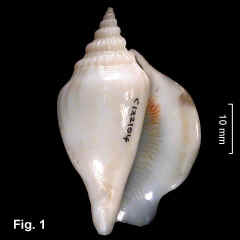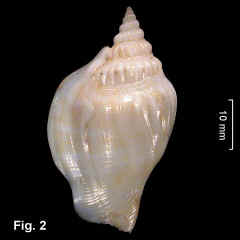|
|
|
|
|
Strombus dilatatus Swainson, 1821 Description: Shell of moderate weight, lip widely flared. Spire whorls with axial ribs from periphery to suture; spiral sculpture of single cord at top of whorls and numerous spiral threads, strongest at top of whorls and fading out at bottom. Last whorl with ventral surface smooth; dorsal surface with 3-6 axial folds, weakly nodulose on shoulder. Base with about 12 spiral cords. Columella callus thick, smooth, swollen centrally. Outer lip flared, thickened in mature shells, extending upward onto two whorls; stromboid and posterior notches wide and shallow; interior lirate along whole length. Exterior colour of broad, tan spiral bands on white background; aperture and callus white; deep interior of aperture with purple-brown lirae. Operculum corneous, long, thin, serrated. Periostracum very thin, translucent tan. Size: Up to 73 mm in length. Distribution: Indo-West Pacific. In Australia, Torres Strait southwards to Sydney, plus a few north-western Australian records. Habitat: Subtidal, 4-73 m on sandy mud. Common in the tropics, rare in NSW. Comparison: This species is similar to Strombus hickeyi Willan, 2000, which occurs in Queensland but not in NSW. But S. dilatatus is larger and smoother, the spire is lower, the nodules on the spire whorls are stronger and less numerous, and there is dark purple colouration deep within the aperture (Willan, 2000). Remarks: Most of the NSW specimens in the Australian Museum are fossil shells dredged from Sydney Harbour by the dredge Triton. Figs. 1,2: Sydney Harbour, dredge Triton (C.122104) |

